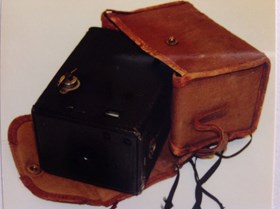Narrow Results By
- Date
- 1900 – 1920
- Material
- paper; metal; skin; glass
- Catalogue Number
- 104.41.1081
- Description
- One Kodak No. 2 Brownie box camera (a) in brown canvas case (b). Inside back of camera reads: “No. 2 Brownie camera. Model C. U.S. Patents Sept. 25, 1894; April 11, 1899; Jan. 21, 1902; April 14, 1903. Made by Eastman Kodak Co., Rochester, N.Y., U.S.A.” Handwritten inside of canvas case reads: “Dor…
1 image
- Title
- Box Camera
- Date
- 1900 – 1920
- Material
- paper; metal; skin; glass
- Dimensions
- 11.0 x 8.0 x 14.0 cm
- Description
- One Kodak No. 2 Brownie box camera (a) in brown canvas case (b). Inside back of camera reads: “No. 2 Brownie camera. Model C. U.S. Patents Sept. 25, 1894; April 11, 1899; Jan. 21, 1902; April 14, 1903. Made by Eastman Kodak Co., Rochester, N.Y., U.S.A.” Handwritten inside of canvas case reads: “Doris Earl Gammon. 220 Bow Ave. Banff Alberta Canada. “ Old address crossed out reads: “16 Old Compton St. London W1”.
- Subject
- photography
- Doris Gammon
- Credit
- Gift of Doris Gammon, Banff, 2000
- Catalogue Number
- 104.41.1081
Images
This material is presented as originally created; it may contain outdated cultural descriptions and
potentially offensive content.
Read more.
- Date
- c. 1910
- Material
- leather; metal; glass; wood; plastic; textile
- Catalogue Number
- 104.41.0249
- Description
- Buster Brown box camera with brown leather handle. Solid structure with black textile covering made to resemble leather. The front of the camera has a hole that likely once held a lens. There are two smaller holes in the upper corner of the front, which contain small glass parts. There is also meta…
1 image
- Title
- Box Camera
- Date
- c. 1910
- Material
- leather; metal; glass; wood; plastic; textile
- Dimensions
- 13.5 x 9.7 x 15.9 cm
- Description
- Buster Brown box camera with brown leather handle. Solid structure with black textile covering made to resemble leather. The front of the camera has a hole that likely once held a lens. There are two smaller holes in the upper corner of the front, which contain small glass parts. There is also metal hardware holding the front exterior panel to the structure. One side has a round hole with glass held by metal hardware, creating a viewfinder. There is also a metal winding mechanism, and a lever for the shutter release. The lever activates a mechanism that quickly uncovers and then re-covers the inner lens. The rear part of the camera has a small round, red-tinted window that would have shown the number for the section of film in position. At the top is a metal hinge that can be lifted to open the back panel, which comes down and is connected with a textile hinge. The top of the camera has a leather handle attached with metal pegs. The leather handle is worn, but you can see that it has been engraved by the manufacturer with the text: “No. 2A BUSTER BROWN”. There is also a viewfinder on the front corner. When the metal latch is opened, the rear panel opens and the interior cartridge can be seen. Pulling out the handle of the winding mechanism on the side of the camera releases the cartridge so that it can be removed. It’s a wooden box with a lens on the front and it has compartments for spools that hold the film. There is a spool in one side, but the other is empty. There are also two metal rollers that would hold the film in place. One side of the wooden cartridge is engraved with the following text: “MFD. BY”; “ANSCO COMPANY”; “BINGHAMTON, N.Y.”; “U.S.A.”; “PATENTED”; “JUNE 23 1903”; “SEPT. 20 1910”; “OTHER PAT. PENDING”; “FOR 6A OR 6B FILM”. Above the engraving is some handwriting in pencil that reads “6-A”; “2 1/2 x 4 1/2”. link to pdf of user manual: http://www.cameramanuals.org/agfa_ansco/ansco_buster_brown_camera.pdf
- Credit
- Gift of Don Harmon, Banff, 1985
- Catalogue Number
- 104.41.0249
Images
This material is presented as originally created; it may contain outdated cultural descriptions and
potentially offensive content.
Read more.




